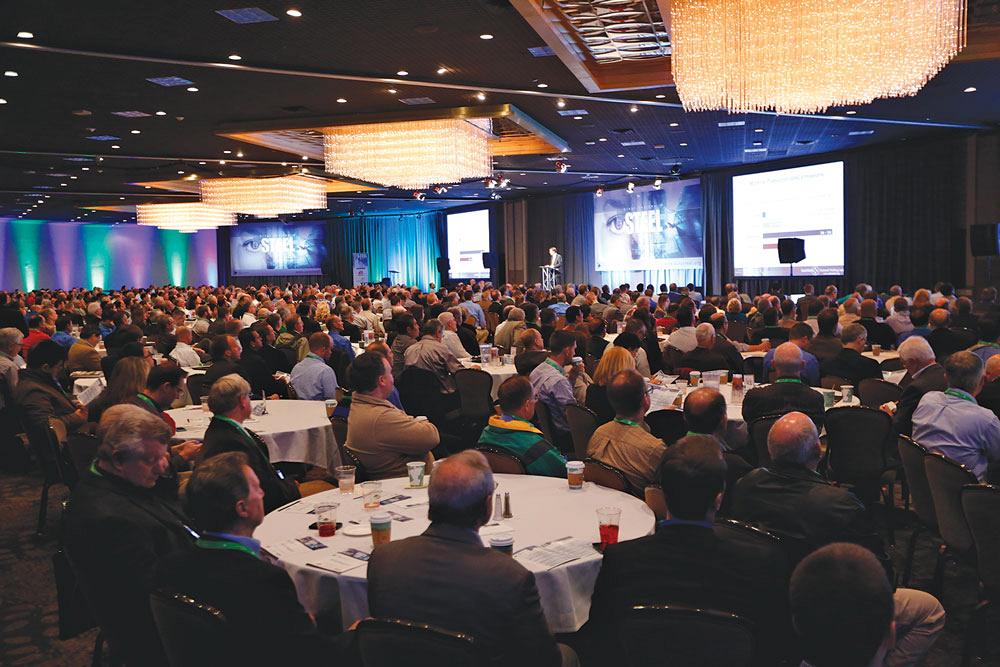Contributing editor
- FMA
- The Fabricator
- FABTECH
- Canadian Metalworking
Categories
- Additive Manufacturing
- Aluminum Welding
- Arc Welding
- Assembly and Joining
- Automation and Robotics
- Bending and Forming
- Consumables
- Cutting and Weld Prep
- Electric Vehicles
- En Español
- Finishing
- Hydroforming
- Laser Cutting
- Laser Welding
- Machining
- Manufacturing Software
- Materials Handling
- Metals/Materials
- Oxyfuel Cutting
- Plasma Cutting
- Power Tools
- Punching and Other Holemaking
- Roll Forming
- Safety
- Sawing
- Shearing
- Shop Management
- Testing and Measuring
- Tube and Pipe Fabrication
- Tube and Pipe Production
- Waterjet Cutting
Industry Directory
Webcasts
Podcasts
FAB 40
Advertise
Subscribe
Account Login
Search
Lightweighting still dominates Great Designs in Steel seminar
Forming, press, die, laser, and joining technologies and fortifying designs bookend steel advancements
- By Kate Bachman
- March 23, 2018
- Article
- Bending and Forming
Lightweighting innovations continue to dominate sessions planned for the 2018 Great Designs in Steel conference, to be held May 16 this year at the Laurel Manor Conference Center in Livonia, Mich.
This conference is one of the rare opportunities to see rival automakers come together to achieve a common goal—better vehicular fuel efficiency via lightweighting—as well as to implement other automotive manufacturing improvements.
Automakers Abound
Automakers GM, FCA, and Honda, as well as myriad other automotive industry professionals and spokespersons for the steel industry, will present their research and share some of their findings.
GM will discuss its use of advanced high-strength steel (AHSS) technologies in the Chevy Silverado.
Honda will unveil the world’s first 3-D bent and quenched A-pillar technologies in the 2019 Acura NSX, as well as advancements in ultrahigh-strength steel (UHSS) forming in the 2019 Acura RDX.
FCA, co-presenting with Gestamp, will unveil its research findings about hot stamped steel in a one-piece door ring in the 2019 Dodge Ram (see Figure 1).
New Steels Surface
As in previous years, several steel producers’ presentations will introduce newly developed steel grades. This year TimkenSteel will showcase its Ultrapremium™ and Endurance Steels, designed to resolve some of the problems related to earlier steel grade generations. ArcelorMittal will discuss door lightweighting using its ultra-thin AHSS reinforced with low-density carbon fiber-reinforced epoxy materials. AK Steel recently introduced its ULTRALUME® PHS press-hardenable steel for hot stamping applications less than 1,500 MPa, in cold-reduced thicknesses of 1 to 3 millimeters and a maximum width of 1,524 mm.
Hot stamping technology is used for A- and B-pillar reinforcements, roof rails, side-wall members, bumpers, beams, and other crash management components (see Figure 2). The hot stamping process addresses the forming and springback issues inherent in higher-strength steels and conventional cold rolling (see Figure 3).
Five presentations focus on AHSS components in crashes, specifically UHSS and DP980.
Beyond Materials
Technology tracks will focus on forming techniques, press technology, dies, lasers, joining techniques and products, and fortifying designs.

High-ranking steel industry executives such as Nucor Corp. President and CEO John Ferriola (right) and AK Steel CEO and Director Roger Newport typically are present at the event. Ferriola will give the keynote. Photo of John Ferriola courtesy of Getty Images; Photo of Roger Newport courtesy of the Steel Market Development Institute (SMDI).
Of special interest to stampers, Johan Nilsson of Gestamp will present on press-hardened and roll-formed lightweight bumpers in steels with enhanced strengths.
One of STAMPING Journal’s R&D Update authors, Ali Fallahiarezoodar of The Ohio State University’s Center for Precision Forming will enlighten attendees on how a servo-driven mechanical press can be used to improve AHSS drawing.
Hitachi Metals America will delve into the topic of die steels that are designed to increase tooling performance for AHSS parts.
The challenges of hole punching in AHSS and possible solutions also will be addressed.
Several presentations reveal progress in finding solutions to problems related to press hardening, including one by CBMM on improving bendability and resistance to hydrogen embrittlement in press-hardening steels (see Figure 4).
Low-carbon Lightweighting
In the face of competing metal types, such as aluminum, and competing nonmetallic materials, such as carbon fiber, SMDI has made a marked distinction between lightweighting and low-carbon lightweighting.
For five consecutive years, the event has included a session citing a study commissioned by the Steel Recycling Institute (SRI), a business unit of the American Iron and Steel Institute, and conducted by the University of California Santa Barbara Automotive Materials Comparison Model (UCSB Model v5). The study claims that AHSS is more environmentally friendly than aluminum, if a vehicle’s total emissions—during its production, as well as its tailpipe emissions--are factored in.
“Lightweighting is often cited as an important way to reduce greenhouse gas (GHG) emissions from light-duty vehicles. This is misleading, as the ultimate goal is not lower weight, but lower emissions. Focusing only on lower weight may lead to the selection of light materials, such as aluminum and magnesium, which are emissions-intensive in their production. The correct term and goal is low-carbon lightweighting, meaning lightweighting that’s achieved with low-emitting light materials, such as advanced high-strength steels,” the SMDI states on its website. S
Steel Market Development Institute, www.autosteel.org/great-designs-in-steel/gdis-2018.aspx
About the Author

Kate Bachman
815-381-1302
Kate Bachman is a contributing editor for The FABRICATOR editor. Bachman has more than 20 years of experience as a writer and editor in the manufacturing and other industries.
subscribe now

The Fabricator is North America's leading magazine for the metal forming and fabricating industry. The magazine delivers the news, technical articles, and case histories that enable fabricators to do their jobs more efficiently. The Fabricator has served the industry since 1970.
start your free subscription- Stay connected from anywhere

Easily access valuable industry resources now with full access to the digital edition of The Fabricator.

Easily access valuable industry resources now with full access to the digital edition of The Welder.

Easily access valuable industry resources now with full access to the digital edition of The Tube and Pipe Journal.
- Podcasting
- Podcast:
- The Fabricator Podcast
- Published:
- 04/16/2024
- Running Time:
- 63:29
In this episode of The Fabricator Podcast, Caleb Chamberlain, co-founder and CEO of OSH Cut, discusses his company’s...
- Trending Articles
How to set a press brake backgauge manually

Capturing, recording equipment inspection data for FMEA

Tips for creating sheet metal tubes with perforations

Are two heads better than one in fiber laser cutting?

Hypertherm Associates implements Rapyuta Robotics AMRs in warehouse

- Industry Events
16th Annual Safety Conference
- April 30 - May 1, 2024
- Elgin,
Pipe and Tube Conference
- May 21 - 22, 2024
- Omaha, NE
World-Class Roll Forming Workshop
- June 5 - 6, 2024
- Louisville, KY
Advanced Laser Application Workshop
- June 25 - 27, 2024
- Novi, MI




























